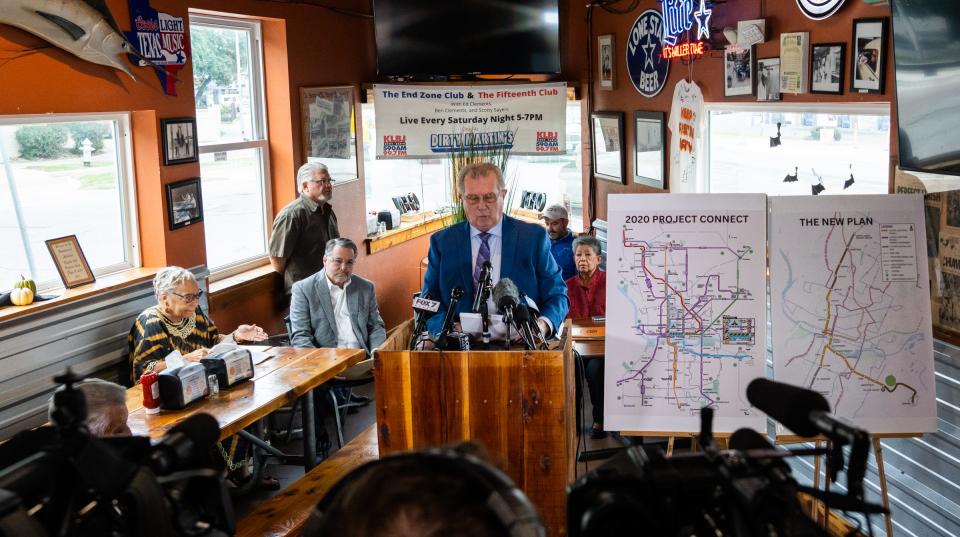Austin transit officials held the first of six open house events Thursday as part of an environmental review of the city’s proposed light-rail system, kicking off a process that will take more than 1½ years, with matching federal funds at stake.
Last summer, citing ballooning cost estimates due to inflation, officials approved a downsized version of the proposal: a 9.8-mile line that stretches north, south and east of downtown Austin. The plan calls for 15 stations, an operations and maintenance facility in East Austin, and a number of smaller maintenance and storage facilities for the line.
But the plans are not final. Officials at the Austin Transit Partnership, the local government corporation created by the city and Capital Metro to deliver the light-rail system, have not finalized where the stations would be. Planners are also weighing whether a proposed bridge carrying the line over Lady Bird Lake should be elevated, how the line would run on Riverside Drive and how much pedestrian walkway space to incorporate.
The Thursday event, held on the University of Texas campus, was part of a 45-day public input period required by federal law. Feedback gleaned from residents during the six in-person events and online will inform the environmental review and guide the Austin Transit Partnership’s decision-making process, said Jennifer Pyne, the partnership’s executive vice president of planning and risk management.
Whether the proposal will receive federal funding and how much hinges on the environmental review, Pyne said. Current plans rely on a 50% match in grant funding from the Federal Transit Administration. A finance plan published last summer estimated the system would cost between $4.5 billion and $5.1 billion.
How does the federal review process work?
The public input period began Jan. 19 and will run through March 4. This process began after the Federal Transit Administration found the project was “sufficiently developed” to allow for public comment and an environmental impact review, according to a notice published last month.
Feedback received during the public input period will inform a preliminary review — called a draft environmental impact statement — slated for release this fall. Once published, this document will provide the most comprehensive overview to date of the project’s impacts.
Another public input period will follow the publication of the draft environmental impact statement. Feedback gathered then will inform the final version of the review, which is slated for release in the fall of 2025.
A “record of decision” — a formal announcement that the project has met the requirements of the federal process — could accompany the final environmental impact statement. This declaration would serve as a green light to start construction, though changes could be made afterward.
Austin Transit Partnership officials want to speed up the process. To do so, the board of directors on Jan. 24 approved a contract, costing at least $900,000, for services from Pinyon Environmental, a Colorado-based environmental consulting firm.
Pinyon Environmental will work directly with the Federal Transit Administration on behalf of the partnership, said Brad Cummings, the Austin Transit Partnership’s senior vice president of procurement and contract management.
For the initial public input period, officials planned for five, in-person and one remote event to gather feedback, Pyne said. You can register ahead of the remaining events at atptx.org/events:
-
Feb. 10 from 10 a.m. to 2 p.m. at the Montopolis Recreation Center, 1200 Montopolis Drive.
-
Feb. 12 from 5 to 8 p.m. at the League of Women Voters Cafetorium, 3908 Avenue B.
-
Feb. 22 from 5:30 to 7 p.m. in a Zoom meeting.
-
Feb. 27 from 4:30 to 7:30 p.m. at Twin Oaks Branch Libary, 1800 S. Fifth St.
-
Feb. 29 from 7:30 to 9 a.m. at St. David’s Episcopal Sumners Hall, 301 E. Eighth St.
Pyne said a report detailing what feedback was received would be published sometime in March.
What about the plan’s Crestview Station, airport extensions?
Two “priority extensions” in the plan approved by Austin officials last summer are not set to be included in the federal environmental review of the 9.8-mile line.
The extensions would connect the proposed Yellow Jacket station to Austin-Bergstrom International Airport and a proposed station on 38th Street with the existing Crestview Station on the Red Line, CapMetro’s six-day-a-week passenger rail between Leander and downtown Austin.
Pyne said the proposed extensions could be incorporated into the review later if additional funding is identified.
“I do think there’s a lot of interest in those priority extensions,” she said.
Whether additional funding will be allocated — and the source of the money — remains to be seen. As planned, and per the cost estimates the partnership published last summer, the system’s cost per mile would be between $459 million and $520 million.
What about the ongoing legal battle over Project Connect?
Seeking to halt the project, opponents of Project Connect, a $7.1 billion public transportation investment approved by Austin voters in 2020, filed a lawsuit last fall against members of the City Council and the Austin Transit Partnership board of directors.
The light-rail system is the centerpiece of Project Connect, which includes plans for new high-frequency bus routes, improvements to the Austin area’s existing commuter rail offerings and other transportation infrastructure improvements. By a margin of more than 15 percentage points, voters approved raising the ad valorem property tax rate by 8.75 cents to help pay for the project — an increase of nearly 20% to the city’s tax rate.

Last month, the City Council and Austin Transit Partnership denied the claims in the lawsuit, court records show. They are represented by Norton Rose Fulbright, a law firm to which the City Council voted in December to pay up to $350,000 to fend off the lawsuit.
The lawsuit, in part, hones in on the downsized plan approved by officials last summer, which the plaintiffs allege changed to a degree that the city lost its authority to continue drawing taxes to fund the project. The lawsuit also touches on elements of the project that are subjects in the ongoing federal environmental review, including the proposed operations and maintenance facility in East Austin.
This article originally appeared on Austin American-Statesman: Austin light-rail system gets public input
Signup bonus from





